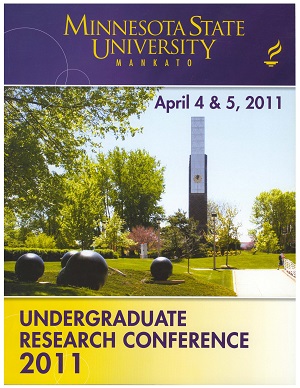Isomorphous Substitutions of Calcium by Dysprosium in the Structure of Synthetic Vanadate Apatite
Location
CSU 253/4/5
Start Date
4-4-2011 11:00 AM
End Date
4-4-2011 12:30 PM
Student's Major
Biological Sciences, Chemistry and Geology
Student's College
Science, Engineering and Technology
Mentor's Name
Lyudmyla Ardanova
Mentor's Department
Chemistry and Geology
Mentor's College
Science, Engineering and Technology
Description
Compounds with the apatite structure had the general composition M10(EO4)6(X)2, where M was univalent to trivalent cations (Ca, Sr, Ba, Cd, Eu, Y, La, Na, K and others); E was tetravalent to hexavalent cations P, V, As, Si, Ge, S, Cr and others; and X represented anions OH, F, Cl, Br, I, O. Hydroxyapatite Ca10(PO4)6(OH)2 was particularly interesting among them because of its chemical similarity to the principal inorganic constituent of bone tissue. Due to its absolute biocompatibility with living tissues, calcium hydroxyapatite ceramics were widely used as biomaterials in medicine (stomatology, maxillofacial surgery, traumatology, orthopedy). Apatites with the hydroxovanadate structure, Ca5(VO4)3OH was not studied well. These compounds could be used as luminescent substances, laser materials and catalysts.
An important feature of apatite–like compounds was that many different kinds of elements could substitute for the major constituents in their crystal structures. These substitutions, called isomorphous replacements, resulted in substances known as solid solutions, and presented a very interesting subject matter for investigation in solid state chemistry.
In this work we studied the isomorphic substitution of trivalent dysprosium for calcium in hydroxovanadate with apatite structure under the scheme: Ca2+ + OH-→ Dy3+ + O2-. Isomorphic substitutions in system Ca5-xDyx(VO4)3(OH)1-xOx , were studied by X-ray powder diffraction analysis. Samples were prepared by nitric-tartaric solutions method and calcined at final temperature of 820°C. Solid solutions formed in the systems Ca5-xDyx(VO4)3(OH)1-xOx had substitutional limits 0
Isomorphous Substitutions of Calcium by Dysprosium in the Structure of Synthetic Vanadate Apatite
CSU 253/4/5
Compounds with the apatite structure had the general composition M10(EO4)6(X)2, where M was univalent to trivalent cations (Ca, Sr, Ba, Cd, Eu, Y, La, Na, K and others); E was tetravalent to hexavalent cations P, V, As, Si, Ge, S, Cr and others; and X represented anions OH, F, Cl, Br, I, O. Hydroxyapatite Ca10(PO4)6(OH)2 was particularly interesting among them because of its chemical similarity to the principal inorganic constituent of bone tissue. Due to its absolute biocompatibility with living tissues, calcium hydroxyapatite ceramics were widely used as biomaterials in medicine (stomatology, maxillofacial surgery, traumatology, orthopedy). Apatites with the hydroxovanadate structure, Ca5(VO4)3OH was not studied well. These compounds could be used as luminescent substances, laser materials and catalysts.
An important feature of apatite–like compounds was that many different kinds of elements could substitute for the major constituents in their crystal structures. These substitutions, called isomorphous replacements, resulted in substances known as solid solutions, and presented a very interesting subject matter for investigation in solid state chemistry.
In this work we studied the isomorphic substitution of trivalent dysprosium for calcium in hydroxovanadate with apatite structure under the scheme: Ca2+ + OH-→ Dy3+ + O2-. Isomorphic substitutions in system Ca5-xDyx(VO4)3(OH)1-xOx , were studied by X-ray powder diffraction analysis. Samples were prepared by nitric-tartaric solutions method and calcined at final temperature of 820°C. Solid solutions formed in the systems Ca5-xDyx(VO4)3(OH)1-xOx had substitutional limits 0
Recommended Citation
Yun, Jin-Ho. "Isomorphous Substitutions of Calcium by Dysprosium in the Structure of Synthetic Vanadate Apatite." Undergraduate Research Symposium, Mankato, MN, April 4, 2011.
https://cornerstone.lib.mnsu.edu/urs/2011/poster-session-B/27




